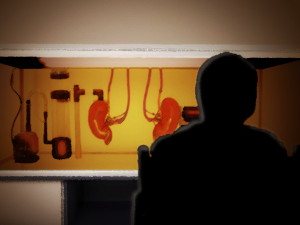Dr. Jasmine A. Connell1,2 and Dr. Diana Rohlman3
1Department of Nephrology, Groom Lake Laboratories; 2Center for Ethical Cloning, Groom Lake Medical Center; 3Groom Lake Publishing Services, Groom Lake, Nevada, United States of America
Corresponding author: Jasmine A. Connell, connellj@groomlakelab.edu
Art by Scarlett O’Hairdye
Jasmine A. Connell received her Bachelors of Science degree in 1975 at Oregon State University. She received her medical degree from the University of Pennsylvania, followed by a PhD at University of Massachusetts in comparative anatomy. She continued at the University of Massachusetts with a three-year post-doctoral position in the laboratory of Dr. D. Parson, who pioneered early organ cloning techniques using human cells. Dr. Connell created the first successful human kidney using intestinal cells from a human donor. The following case study is published as presented by the underwriting author, Diana Rohlman (Groom Lake Publishing Services).
#
I arrived at the Center for Ethical Cloning filled with excitement and trepidation. I didn’t know what to expect. Despite my medical degree, I had spent minimal time with patients. The last ten years had been spent in a lab, logging hours at microscopes and flow cytometers and any number of highly technical instruments to create a medical miracle. I suppose it should not have been a surprise that I entered a medical facility, rather than the drab laboratory I would have expected, but it was.
A large printer next to the closest nurse’s desk spewed forth color pictures: A thin brunette, her skin sallow, lay asleep on a hospital bed, hooked up to a dialysis machine. Her picture was captioned in stark, uncaring terms: 32-year-old female, Caucasian, Kidney. A small boy, scars bisecting his chest numerous times, his lips tinged blue; 8-year-old male, Hispanic, Heart. A portly man, jaundiced, broken veins in his nose attesting to a love of the drink, sat limply; 53-year-old male, Caucasian, Liver, poor candidate.
I stepped up to the information desk tentatively. I could smell the disinfectant. Suddenly I began to wonder if I was ready for this job.
Before I could turn around, give in to my nerves, and discreetly sneak out the front door, a nurse in an impeccable white medical jacket saw me and strode over.
“Welcome to Dr. Jorgen’s office,” she said briskly, “Please fill out those forms.” With an air of practiced efficiency she took a slim stack of printouts, slid them onto a clipboard, and affixed a pen. She handed the entire package over, looking up only when I declined the offering. This time, she saw the small nameplate affixed to my blazer. The nice guard had given it to me when I entered the facility. He had even wished me good luck with the new job. Her eyes widened.
“Oh, I’m sorry …” She cleared her throat, dropped the clipboard behind the desk. “You’re Dr. Connell … I–”
I smiled, trying to ignore the butterflies in my stomach. “I always wanted to make an impression,” I joked.
The nurse–her nameplate identified her as Kathy–laughed gratefully.
“Then I am glad I could help fulfill your wishes! You don’t have to fill out any forms, but would you like a quick tour before you meet Dr. Jorgen?”
I had been looking around curiously. At first glance, the medical facility seemed like any other sterile facility, complete with white walls, blue and beige accents, and an easy to clean, nondescript floor. The ceilings were too high though, the doors too wide. Everything seemed just slightly off-kilter, as though a medical facility had been superimposed onto an existing structure.
Kathy must have been used to the disorienting sensation, because she laughed again, this time in sympathy, and launched into a quick explanation.
“The Center used to be an old factory, to tell the truth. However, Dr. Jorgen completely refitted it with new, state-of-the art equipment, the highest technology, and a security system that the Department of Defense envies.”
I raised my eyebrows. “That’s quite impressive.”
Kathy nodded, and I could tell she thought quite highly of the work Dr. Jorgen had done.
“Then let’s start with a tour.” She stepped out from behind the desk, setting down a stack of papers.
To read the rest of this story, check out the Mad Scientist Journal: Spring 2014 collection.
Diana lives in the Pacific Northwest, invariably spending the rainy days inside, writing, with a glass of wine nearby, and her dog offering helpful critiques. Her website is http://sites.google.com/site/rohlmandiana or check her out on Amazon (amazon.com/author/dianarohlman).
Scarlett O’Hairdye is a burlesque performer, producer and artist. To learn more, visit her site at www.scarlettohairdye.com.
Follow us online:
